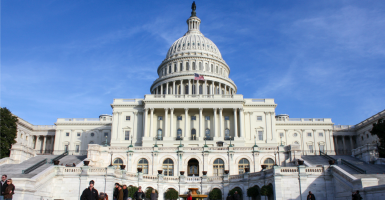America’s interstate highway system, which broke ground in 1956 and was completed in the early 1990s, enables us to affordably travel more than 3 trillion miles per year on its roads.
But even 20 years after its completion, funding for maintenance of the interstate highway system remains in the hands of Congress and federal bureaucrats. In this top-down arrangement, the federal government acts as a middle man by collecting gas tax dollars and then apportioning them back to states, replete with federal mandates.
This approach has led to serious problems: The Highway Trust Fund—which funds federal road and transit projects—routinely spends more than it receives in taxes, often on projects wholly unrelated to the highway system. This year, the fund is slated to run a $13 billion deficit and is expected to exhaust its available cash by August. The cumulative shortfall is projected to reach $168 billion within a decade.
The latest failure of Congress to address the issue—typical of how it handles most tough decisions—has prompted some lawmakers to recognize that enough is enough. Earlier this month, Sen. Mike Lee, R-Utah, and Rep. Ron DeSantis, R-Fla., introduced the Transportation Empowerment Act, which would end federal handwringing over transportation spending and return authority to the states, where it belongs.
The proposal would reduce the federal gas tax from 18.3 cents to 3.7 cents over five years and bring spending in line with revenues, leaving in place enough funding to manage the truly interstate aspects of the highway system. The drawdown would put states in the driver’s seat regarding the planning and funding of their transportation projects. By taking this approach, transportation governance would see significant improvements in the following aspects:
Accountability: State and local governments are more accountable to constituents than the federal government. Allowing transportation decisions to be made at the state level will give users much more say in exactly how they want their transportation systems run. States could spend less on transportation or double down on transit construction. Either way, they would be accountable to voters, who could provide immediate input. For instance, in Michigan last month, voters rejected a bad tax proposal that would have upped gas taxes for road construction and increased funding for a long list of unrelated projects. Such an outright rejection of a bad deal for motorists could not happen at the federal level.
Reliability: Because construction projects require extensive planning over long periods of time, legislative uncertainty at the federal level hampers states’ ability to effectively plan infrastructure projects. The Department of Transportation notes that, since 2008, there have been 33 short-term patches instead of one long-term plan. This federal uncertainty has led 15 states to implement or consider project delays and cancellations over just the last year and continues to loom with the inevitable congressional brinkmanship this summer. Why should states have to deal with this nonsense in Washington when they could cut out the middleman and fund projects themselves?
Efficiency and Affordability. In the current system, the federal government siphons gas taxes from motorists, then distributes them back to the states after skimming a portion off the top. States could cut out the unnecessary middle man and gain efficiency savings right off the bat. More importantly, ending federal control of transportation dollars would cut out unnecessary federal mandates, which can add more than 20 percent to labor costs, cause project delays and divert resources away from where they are needed most. Removing the federal handcuffs would allow states to make their own priorities and allocate their transportation spending however they choose.
Given the advantages that would accrue from localizing governance of transportation, lawmakers should look to downsize the federal government’s role and allow states and localities to take the reins. The Lee-DeSantis proposal takes a robust approach to doing just that, which would lead to greater accountability, reliability, efficiency and affordability within our transportation system. It’s time to bring transportation decisions out of Washington and move them closer to home.































